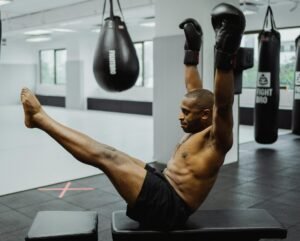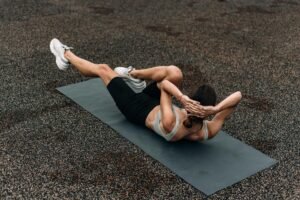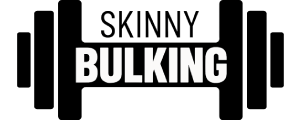A strong core is essential for good posture, balance, and overall fitness. It is the foundation of all movements, from picking up a grocery bag to running a marathon. However, getting those abs in shape can be challenging, especially if you don’t know where to start. With so many different exercises and workout routines out there, it can be overwhelming to figure out what will work best for you. That’s why we’ve compiled a list of the nine best ab workouts you should be doing right now. These exercises are effective and easy to incorporate into your daily routine, and they will help you build a stronger, more stable core. From planks and crunches to leg raises and Russian twists, we’ve got you covered with this comprehensive guide to ab workouts. So, whether you’re a fitness enthusiast or just starting out, read on to learn how to strengthen your core and achieve your fitness goals.
1. The importance of core strength

Image: pexels
Core strength is vital for good posture, balance, and stability. The core muscles – which include the rectus abdominis, obliques, and transverse abdominis – are responsible for supporting the spine, pelvis, and hips. When these muscles are weak or imbalanced, it can lead to poor posture, decreased mobility, and even injury.
Having a strong core is not just about looking good in a swimsuit. It can improve your overall athletic performance, from running to weightlifting, and help reduce your risk of injury. A strong core can also improve your everyday life, from carrying groceries to playing with your kids or grandkids.
In addition to the physical benefits, having a strong core can also boost your confidence and self-esteem. When you feel strong and stable in your body, you’re more likely to feel empowered in other areas of your life as well.
So, whether you’re a fitness enthusiast or just looking to improve your overall health and well-being, adding core workouts to your routine is a must.
2. The anatomy of the core: what muscles are involved
Before we delve into the ab workouts that you should be doing right now, let’s take a moment to understand the anatomy of the core and the muscles involved. The core is made up of multiple muscles that work together to support and stabilize the spine, pelvis, and hips. This includes the rectus abdominis, transverse abdominis, internal and external obliques, erector spinae, and multifidus muscles.
The rectus abdominis muscle, commonly referred to as the “six-pack,” is responsible for flexing the trunk and bringing the ribs towards the pelvis. The transverse abdominis muscle, on the other hand, is located beneath the rectus abdominis and is responsible for compressing the abdomen and stabilizing the spine.
The internal and external obliques are located on the sides of the torso and are responsible for rotation and side bending of the trunk. The erector spinae muscles run parallel to the spine and are responsible for extending and rotating the spine. Lastly, the multifidus muscles are located deep in the back and are responsible for stabilizing and supporting the spine.
By understanding the muscles involved in the core, we can target them effectively with the right exercises. That’s why incorporating a variety of ab workouts that target these muscles is key to building a strong core and improving overall fitness.
3. Why you should mix up your core workouts
Doing the same core workout over and over can result in hitting a plateau, where your body gets used to the same movements and stops making progress. That’s why mixing up your core workouts is essential to keep your body challenged and progressing towards a stronger core.
By changing up your routine, you’ll engage different muscle groups, which will help break through any plateaus and prevent boredom in your workouts. Plus, varying your exercises will help you develop a more well-rounded core, enhancing your overall strength and stability.
Incorporating different types of ab workouts, such as planks, Russian twists, bicycle crunches, and leg raises, can help you target different areas of your core, including your rectus abdominis, obliques, and transverse abdominis. This will not only help you achieve a more defined six-pack, but also help improve your posture, reduce your risk of injury, and improve your athletic performance.
So, if you want to build a stronger core, make sure to mix up your ab workouts regularly, and challenge yourself with new exercises and variations. Your body will thank you for it!
4. The nine most effective ab workouts for a stronger core
If you want to build a strong core, then performing effective ab workouts is essential. Here are the nine most effective ab workouts that you should be doing right now for a stronger core:
1. Planks
2. Russian twists
3. Bicycle crunches
4. Leg raises
5. Sit-ups
6. Mountain climbers
7. Reverse crunches
8. Side plank dips
9. Flutter kicks
Each of these exercises targets your core muscles in a different way, and by incorporating them into your workout routine, you’ll be working all areas of your core. It’s important to remember to engage your core throughout each exercise to ensure that you’re getting the most out of your workout.
It’s also worth noting that while ab workouts are important, they won’t necessarily give you a six-pack. In order to see those coveted abs, you’ll need to have a low body fat percentage. This means incorporating cardio and a healthy diet into your fitness routine.
So, if you’re looking to build a stronger core, be sure to add these nine effective ab workouts to your workout routine and don’t forget to focus on overall fitness and diet as well.
5. Plank variations: the standard plank, side plank, and plank with hip dips
Planks have become a popular workout for those seeking to strengthen their core. The standard plank is easy to execute, yet it provides a great challenge for those looking to increase their strength. By extending the body out in a straight line and holding it up using only the forearms and toes, the standard plank works the entire core, including the lower back, glutes, and thighs.
To add some variety to the standard plank, try incorporating side planks into your routine. This variation targets the obliques, or the muscles located at the sides of the waist. By stacking one foot on top of the other and balancing on one forearm, you’ll be engaging your core in a new way.
Another plank variation that is gaining popularity is the plank with hip dips. This variation requires starting in a standard plank position and then dipping the hips to the left and right sides, engaging the obliques even more. This move can be challenging, but the results are rewarding, as it targets the entire core, including the upper abs, lower abs, and obliques.
Incorporating these plank variations into your workout routine can help you achieve a stronger core, better posture, and improved balance. So, whether you’re a beginner or an experienced fitness enthusiast, adding planks to your workout routine is a great way to strengthen your core and improve your overall fitness level.
6. Leg raises: how to do hanging leg raises and lying leg raises
Leg raises are an excellent way to strengthen your core muscles, including your lower abs. There are two types of leg raises that you can do: hanging leg raises and lying leg raises.
Hanging leg raises are done by hanging from a bar or any other sturdy structure that can support your weight. Start by hanging from the bar with your arms fully extended and your legs straight down. Slowly raise your legs up towards your chest, keeping them straight. Hold for a few seconds at the top and then slowly lower your legs back down. Repeat for several reps.
Lying leg raises are done by lying flat on your back with your hands by your sides. Slowly raise your legs up towards the ceiling, keeping them straight. Hold for a few seconds at the top and then slowly lower your legs back down. Repeat for several reps.
Both hanging leg raises and lying leg raises are great exercises for building strength in your lower abs. Make sure to maintain proper form throughout the exercise and to breathe deeply to engage your core muscles. To make the exercise more challenging, you can add ankle weights or use a stability ball for added resistance. As with any exercise, it’s important to start slowly and gradually increase the intensity and duration over time.
7. Crunches: the standard crunch, bicycle crunch, and reverse crunch

Image: pexels
Crunches are a great way to strengthen your core and tone your abs. The standard crunch is a classic exercise that focuses on the rectus abdominis muscle, also known as the “six-pack.” To do a standard crunch, lie on your back with your knees bent and feet flat on the floor. Place your hands behind your head or across your chest, and slowly lift your shoulders off the ground, keeping your lower back pressed to the floor. Exhale as you lift and inhale as you lower back down.
The bicycle crunch is another great variation of the standard crunch that targets multiple areas of the core, including the obliques. To do a bicycle crunch, lie on your back with your hands behind your head and your legs in a tabletop position. Bring one elbow to meet the opposite knee, then switch sides, bringing the other elbow to the opposite knee. Continue alternating sides, pedaling your legs in a bicycle motion as you crunch up.
The reverse crunch is a variation of the standard crunch that targets the lower abs. To do a reverse crunch, lie on your back with your hands at your sides and your knees bent. Lift your feet off the ground and bring your knees in towards your chest, then slowly lower them back down. Exhale as you lift and inhale as you lower back down. By adding these three crunch variations to your ab workout routine, you’ll be well on your way to a stronger, more toned core.
8. Russian twists: how to do traditional Russian twists and standing Russian twists
Russian twists are a great way to target your core and improve your balance. This exercise can be done in two ways, traditional Russian twists and standing Russian twists.
To do traditional Russian twists, sit on the ground with your knees bent and your feet flat on the floor. Lean back slightly and lift your feet off the ground, balancing on your sit bones. Clasp your hands together and twist your torso to the right, bringing your clasped hands to the right side of your body. Then twist to the left, bringing your clasped hands to the left side of your body. This is one rep. Aim for three sets of 15 reps.
If you want to challenge yourself even more, try standing Russian twists. Stand with your feet shoulder-width apart and your knees slightly bent. Clasp your hands together and twist your torso to the right, bringing your clasped hands to the right side of your body. Then twist to the left, bringing your clasped hands to the left side of your body. This is one rep. Aim for three sets of 10 reps.
No matter which version of Russian twists you choose, be sure to engage your core muscles throughout the exercise and focus on your form. As always, if you experience any pain or discomfort, stop the exercise immediately and consult with a medical professional.
9. Woodchoppers: the cable woodchopper and the medicine ball woodchopper
If you’re looking for an effective way to strengthen your core and tone your abs, look no further than woodchopper exercises. With two variations to choose from, the cable woodchopper and the medicine ball woodchopper, you’ll be able to work your entire core and improve your balance and stability.
The cable woodchopper involves using a cable machine to simulate the motion of chopping wood. Start by setting the cable to a low weight and standing with your feet shoulder-width apart. Grab the handle with both hands and pull it across your body diagonally, twisting your torso as you do so. Keep your core engaged and your back straight throughout the exercise. Repeat on the other side.
For the medicine ball woodchopper, you’ll need a medicine ball that’s heavy enough to challenge you but not so heavy that you can’t maintain proper form. Start by standing with your feet shoulder-width apart and holding the ball with both hands above your head. Bring the ball down diagonally across your body, twisting your torso as you do so. Keep your core engaged and your back straight throughout the exercise. Repeat on the other side.
Both of these exercises are great for targeting your obliques, which are the muscles on the sides of your abdominals. They also work your shoulders, back, and legs, making them a great full-body workout. Incorporate them into your ab routine for a stronger, more toned core.
10. Tips for getting the most out of your ab workouts
Getting the most out of your ab workouts is essential if you want to achieve a stronger core. Firstly, it’s important to remember that quality is better than quantity. You don’t need to do endless amounts of crunches or sit-ups to see results. Instead, focus on proper form and engaging your core muscles.
Another tip is to incorporate a variety of exercises into your routine. This will help prevent boredom and also challenge your muscles in different ways. Some effective ab exercises include planks, bicycle crunches, leg raises, and Russian twists.
Additionally, it’s important to maintain consistency with your workouts. Aim to work your abs at least 2-3 times per week, and gradually increase the intensity and duration of your workouts over time.
Proper breathing is also important during ab exercises. Exhale on the exertion phase (when you’re contracting your muscles) and inhale during the relaxation phase. This will help engage your core muscles even more.
Lastly, don’t forget to stretch after your workouts. This will help prevent muscle soreness and tightness, and also improve your flexibility. Hold each stretch for 20-30 seconds and focus on deep breathing to help your muscles relax.







Leave a Reply